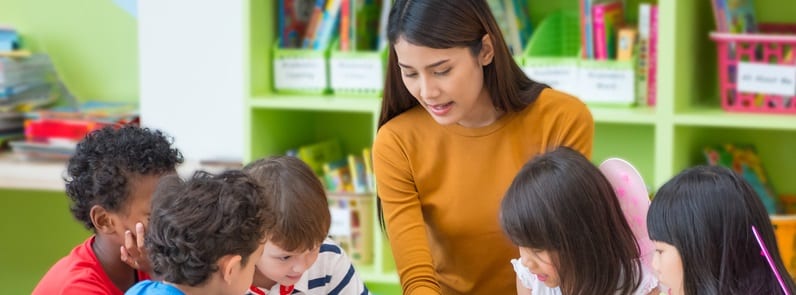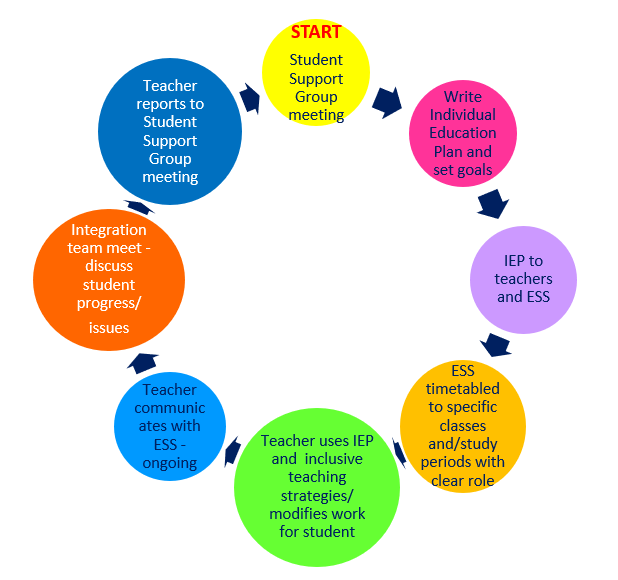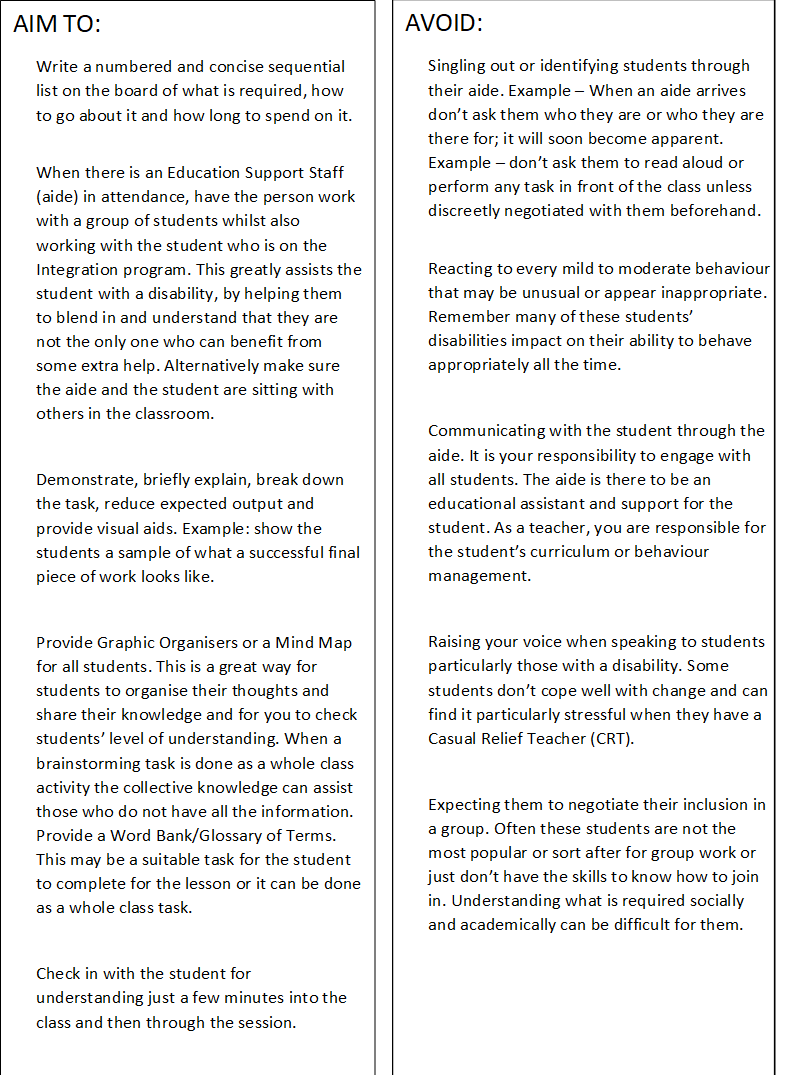
By Sue Pickett
EDITION #3 – Have I set high expectations for myself and every student?
Published – 20th March 2019

Sound inclusive teaching practice provides the tools for all students to reach desired outcomes.
Those of us who are in education are here to inspire young people and help them to experience real life success. I am an educator, a classroom teacher and an Additional Needs Coordinator. I work with students with learning difficulties in a large mainstream secondary school. In this article, I want to show you that you can teach almost anything to anybody. Sometimes, you will need extra resources, new knowledge and a lot more time, but with the right knowledge, skills and supports you can do it. The most important thing is to commit to a philosophy of inclusion.
I use a human rights framework to guide everything I do with students. Human rights are the cornerstone of strong, healthy communities where everyone can participate and be included. Every one of us, regardless of our background, where we live and what we look like, want to feel included and accepted for who we are. A human rights framework steers us away from seeing children with additional needs from a deficit angle, as broken, dysfunctional and unfixable. If we allow that form of thinking in our approach to teaching, then we reinforce negative perceptions around disability. My focus is inclusive practice.
I have come to the fundamental conclusion that as human beings the learning intention for all students is for them ‘to be good at life’. My premise is that all students can learn and develop.
Why is inclusive practice important?
As a teacher, value the pursuit of excellence, individuality and creativity, social and environmental responsibility and respect for diversity and integrity.
There is so much more to the education discourse than academic achievement. All young people have the right and the need to grow their social agency within their peer group and the larger learning community. They have a right to a place where they belong, that is a safe learning environment and is a snapshot of real life outside the school gate. All young people should be challenged and be encouraged to focus on what they can do, not what they can’t.
In the school in which I work, we are guided by a commitment that allows each person to feel safe to and to be themselves. We are committed to challenging every person to think critically, to work in teams, show leadership and achieve success along many pathways. Our school values the pursuit of excellence, individuality and creativity. The deeds that count are social and environmental responsibility and respect for diversity and integrity.
What does inclusive practice look like?
If we deconstruct any classroom of students, catering for those with a learning difficulty is merely an extension of what we all know as a mixed ability classroom.
The profile of the student cohort of any mixed ability classroom is made up of students with:
- different learning preferences
- a disability
- a learning difficulty – which may affect their confidence, organisational skills, ability to start a task, copy from the board, plan for deadlines, use the school diary, speak in front of the class, complete a set of classroom or homework tasks from the textbook
- the ability to manage well in all learning environments, regardless of the skill and knowledge of the teacher.
Sound, inclusive teaching practice embeds instructional methods that serve the needs of all students. Inclusive teaching practice is simply good teaching practice. It is beneficial for all students as it leads all students to desired outcomes.
For those students with additional needs, Individual Education Plans, or Learning Plans (IEP), should be in place to provide you with important information. An IEP should contain information about the student’s diagnosed disability or condition or learning difficulty, and the implications it has on your approach to:
- classroom management
- curriculum delivery strategies
- how the student will demonstrate their understanding.
A school based on inclusive practice
In a school that is oriented toward inclusive practice, the principal and leadership team will be able to articulate what it means. It will be embedded in their own practice, such as their interpersonal communication. The leadership team will understand their responsibility under the law (see more below). There will be a demonstrated commitment to inclusive practice in the daily life of the school. School resources will be invested in Education Support Staff and they will be valued staff members led by a person with a dedicated leadership role.
In figure one below I have represented how a school could implement an approach to inclusive practice that involves Student Support Group meetings, Education Support Staff (ESS) and Individual Education Plans (IEP).

Figure One: A school based approach to inclusive practice that involves Student Support Group meetings.
Education Support Staff (ESS) and Individual Education Plans (IEP)
A classroom based on inclusive practice
In a classroom based on inclusive practice, an observer would see:
- the learning intention written clearly on the board
- examples of what the finished product might look like
- prominent use of visual aids and graphic organisers (diagrams, mind maps)
- the task broken down into smaller units (e.g. plot and chapter summaries, character profiles)
- a range of physical resources to support all learners e.g. books. (Internet research can be complex for many students, who are easily overwhelmed, get lost, find it hard to persist, switch to gaming and quietly go off your radar as they off task.)
- extensive use of glossaries with key terms for the subject
- CLOZE exercise where all of the information can be found on one page.
- the teacher constantly checking in with all students
- step-by-step instructions for homework tasks. (Students who struggle in class to do the work will take these struggles home and will be overwhelmed and confused adding to their frustration, disengagement and poor self-worth).
The practice examples described above are all reflected in the Department’s High Impact Teaching Strategies (HITS) (Department of Education, 2018). High impact teaching strategies are inclusive teaching strategies.
From the student’s point of view
Know your learner and approach each lesson with an aim to make that lesson an interesting, challenging and worthwhile learning experience for all students.
Students with a learning difficulty may display some, or all of the following traits across their school subjects:
- they are less efficient and effective users of learning and thinking strategies than their academically more successful peers
- they have less persistence when faced with difficult tasks
- they have difficulties storing information in memory as well as retrieving it
- they have heightened anxiety
- they lose self-esteem and motivation
- they have diminished social skills
- academic success or failure is attributed to luck
Keep in mind that a student may have a cluster of learning difficulties e.g. attention-deficit disorder, conduct disorders, motivation, language and social and interpersonal difficulties.
The students that I work with in my setting, who experience difficulty, have provided me with feedback Students who are struggling say:
- the classroom was too noisy
- they didn’t know what to do
- they forgot what they had to do
- they didn’t hear or understand the explanation
- the teacher talked too fast
- they lost their books/notes
- no one would tell them what to do
- they couldn’t copy it off the board in time
- they were unable to write accurately or in a reasonable time frame
- they were unable to copy from the board
- they had difficulty focusing.
This leads to the following behavioural problems:
- they have difficulty choosing the best course of action
- they have a short attention span
- they are easily distracted by noise, movement, visual stimuli, or thoughts
- they are unable to transition from one activity to another
- they display immature or inappropriate responses in social encounters
- they become overly excited or unsettled.
As a graduate teacher you will be thinking about making a difference for students. Enjoy the challenge of inclusive practice. Use your knowledge and your own agency to bring about change in your practice to better meet the needs for these students. The work you prepare, the skill set you develop, and successes you have with students will build your capacity to do the very thing you got into education for – to make that difference. Know your learner and approach each lesson with an aim to make that lesson an interesting, challenging and worthwhile learning experience for all students. It is very satisfying to provide meaningful work for a student who might be otherwise disengaged or overwhelmed or ready to give up. This will enhance your teaching skills and knowledge and you will know why you chose this as a career path.
Inclusive practice and the law
For all educational settings, the law is explicit and clarifies the obligations of education providers to ensure students are able to access and participate on the same basis as those without a disability. The Federal Disability Standards for Education 2005 is the law that is pertinent to Disability and Education. It can be found at https://www.education.gov.au/disability-standards-education-2005
Know it! Have a discussion with your mentor about its impact in your school.
You might want to raise these questions with your mentor. The discussion will help you to understand more about the process of inclusion and the approach that is taken by your school.
- Why is this student in a mainstream school?
- How can I possibly follow an Individual Education Plan and prepare material that is only for one student?
- How can I teach a student with additional needs when I have a class of 25?
- What are my obligations to a student with a disability?
Top takeaways for graduate teachers
To support you in your role, I have provided a downloadable document that I have titled Top Ten Teacher Tips. It is designed to provide you with a quick checklist of things to aim for and things to avoid as you work toward becoming a teacher for an inclusive classroom.
Teachers Top Ten Inclusion Tips – Disability in the classroom

